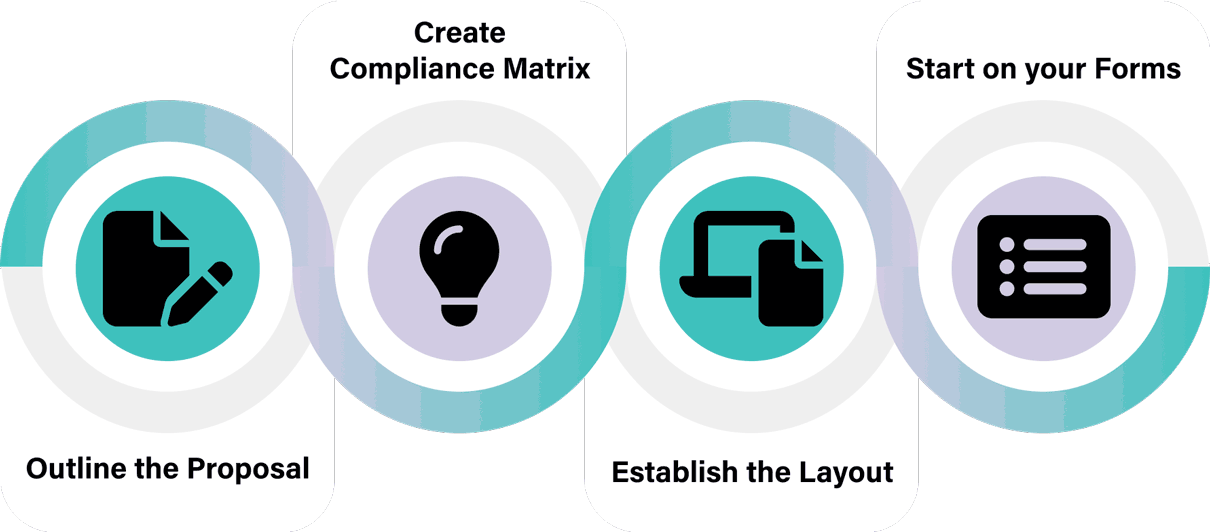Winning proposals don’t just happen by accident. In this blog we’ll outline an efficient proposal process for crafting a proposal that stands out.
Understand the Opportunity
Understanding the opportunity is like understanding the game you’re playing. If you don’t understand the rules, you’ll write a proposal that misses the mark. A strong understanding allows you to craft a proposal that is personalized and impactful. You’ll demonstrate you understand their problem, as well as make your proposal stand out from the crowd.
- Analyze the RFP or Tender: Highlight key requirements, forms, signatures, and deadlines. Read for implied meaning and note any confusion.
- Research the Client: Learn about their industry and their project challenges and goals. Arm yourself with the details that help you customize your proposal.
- Understand the Evaluation Criteria. How the client weights their score provides valuable insights into what they value. Investing your writing time here will help increase your score.
Plan the Proposal
Planning for proposal development is like project management for building a house. Both require a solid foundation and a thoughtful plan to succeed. Planning your proposal helps you avoid content bottlenecks and last-minute compliance hiccups. It also helps you maximize your time and resources budget step by step.

- Outline the Proposal. Follow the mandated outline, including section headings and requirements. Organize a logical flow within this outline, and plan for visuals that support content.
- Create a Compliance Matrix. Use this to cross-reference and confirm numbering, requirements, page limits, and writer response compliance, and identify gaps.
- Establish the Layout. Establishing a clear and consistent layout early on helps your team create a logical flow for readability. It also makes a professional first impression with the client.
- Start on your Forms. Start gathering necessary information early, these will take time.
Craft a Winning Strategy
Why are you the best choice? Crafting a strategy helps you consistently demonstrate your expertise and showcase your value. Without a lot of rewriting. This sets you apart from generic proposals, and positions you as the ideal partner to tackle the challenge.

- Create a Value Proposition. Clearly articulate the unique value you bring to the table. Back that up with evidence and a cost breakdown.
- Identify the Approach. Clearly define how you will address the problem. Be specific and provide a clear timeline for project completion.
- Annotate the Outline. Give writers direction on what you expect, including how the team interprets a requirement or section.
- Storyboard the Narrative. Visually communicate the narrative flow and ensure smooth transitions between sections.
Assemble your Team
Proposal writing is a team sport. By bringing together experts with the right skills at the outset, you ensure you can address every aspect of the client’s needs. This collaborative approach allows you to leverage diverse expertise, leading to a strong, more well-rounded proposal. It also helps you best invest your time and resources.
- Secure the Subject Matter Experts. Know who you need, everyone from sales and functional and technical experts to writers, graphic designers, and legal.
- Divide up the Tasks. Assign specific tasks and highlight content dependencies. When proposal team members understand where their piece of the puzzle fits, it's easier to write and hit deadlines.
- Schedule the Deadlines. Provide a centralized calendar with clearly defined due dates and milestones. Instead of chasing email for updates, the team can quickly access deadlines.
- Hold the Kickoff Meeting. Share the nature of the project, the scope of work, and the win strategy as well as task assignments and schedule.
Suggested content
More on development below!



How Proposal Dashboards Boost Team Accountability and Drive Success
October 10, 2024
Build an Informative and Compelling Narrative
An informative proposal uses clear explanations, relevant data and insightful analysis to empower your readers. A compelling narrative weaves those facts and figures into a persuasive story that captivates readers. This writing combination connects with readers on an emotional level, leaving a lasting impression.
- Cover Letter. Focus on the overall value of your proposed solution, highlighting key points important to the reader.
- Executive Summary. Grab your reader’s attention with a concise overview of your experience and solution.
- Problem Statement. Clearly define the client’s challenges and demonstrate your understanding of its complexities.
- Methodology. Detail your approach, your expertise and proven track record in similar projects.
- Qualifications. Showcase your experience, relevant skills, and any certifications or awards that strengthen your credibility.
- Resumes. Focus on highlighting relevant experience, expertise, and accomplishments that directly address the client's needs and the project requirements.
- Cost Proposal. Present a detailed cost structure, justifying your pricing strategy.
- Call to Action. Be specific; clearly state the action you want the client to take.
- Compliance Matrix. Consider including your compliance matrix. By cross-referencing each requirement with its corresponding section you make things easier to find for readers.
- Forms. Follow the rules and be meticulous. Are wet signatures required? Attention to detail shows the client you've carefully reviewed their requirements and are committed to adhering to their specific format and structure.
Bonus. Reusable content is a good start. But simply copying and pasting content written for someone else won't cut it with this client. Customize with relevant stories and details that provide context that resonates with these readers.
Refine and Strengthen
The review process ensures a polished, compliant and accurate document free of typos and grammatical errors. Reviews also identify gaps, or opportunities for strengthening your value proposition. Whether you use a color team review process or your own review process, reviews help you improve proposal quality and evaluation score.

- Proofread. Read specifically for compliance and errors that undermine your credibility.
- Formatting. Read specifically for accurate formatting and numbering, and images that have slipped off the page.
- Peer Review. Assign a mix of team members and independent reviewers. Provide ample time for review. Ask for specific corrections and ideas for strengthening the proposal.
Bonus. If time is running short, consider a hot wash. A hot wash focuses on review feedback that addresses core issues, such as strategy and approach. This helps you prioritize edits for revisions that truly strengthen your proposal's impact.
Proposal Submission
You’ve put in the hard work, and now it’s time to wow your client. Double-check deadlines and submission requirements.
- Electronic Submission. Ensure the file format is compatible and the file size is manageable.
- Hardcopy Submission. Page through each copy, and verify that every page has been printed. Ensure that every table, chart, graphic, form, and signature is accounted for.
Debrief, Learn and Improve
Win, lose or draw, every proposal experience holds valuable lessons learned. Take some time for a debrief discussion. A debrief helps you understand what worked well and what could be improved.
Recommended: Proposal management explained in detail
Proposal Development Process
Proposal management software can significantly streamline and improve the proposal development process. In fact, industry research demonstrates;
- 33% reduction in proposal cycle time (CSO Insights)
- 10-15% higher win rates (Aberdeen Group)
- Organizations with an RFP tool submit 34 more responses annually, and influence 65% more revenue. (APMP)
XaitPorter helps teams write proposals 70% faster without sacrificing quality:
"For the experts, we’ve bought them more time to write...
For the executives, we’ve bought them more time to consider the strategy, weigh the risk and the return. That’s a big win. That’s buy-in."
- Jeremy Steward, Commercial Manager at Sulmara Subsea
Ready to develop winning proposals faster?
Imagine ditching the scattered documents, reformatting, and last-minute scramble for:
- More time to put your expertise where it counts
- No more formatting and reformatting
- Faster proposal development without sacrificing accuracy or quality
- More winning-quality proposals with the same staff
- A more adaptable process that scales as you grow
Conquer your next proposal with accuracy and speed. With tools specifically designed to eliminate the heavy coordination lift and empower experts to deliver professional, stand-out proposals:









